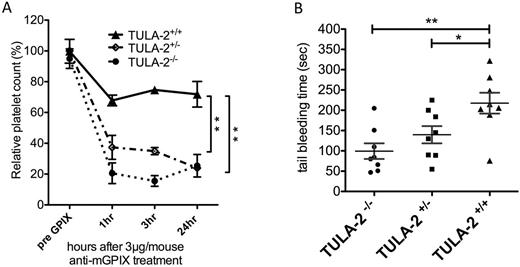Abstract
Heparin-induced thrombocytopenia (HIT) is a life-threatening disease in which IgG antibodies against the heparin-PF4 complex activate platelets via FcγRIIA. We previously reported that TULA-2 serves as a negative regulator of FcγRIIA pathway by dephosphorylating Syk in HEL cells. To further investigate the effect of TULA-2 on the FcγRIIA pathway and HIT, we crossed TULA-2-/- with FcγRIIA+/+ mice. Ablation of TULA-2 resulted in hyperphosphorylation of Syk, LAT, and PLCγ2 in platelets after FcγRIIA activation. Integrin activation, calcium mobilization, and P-selectin exposure were also enhanced in TULA-2-/- murine platelets compared to TULA-2+/+. Further, anti-GPIX antibody-induced HIT-like thrombocytopenia and thrombin generation were also augmented in TULA-2-/- mice (Figure A). We also found that decreased TULA-2 level shortened tail-bleeding time in mice (Figure B), suggesting a role of TULA-2 in physiological hemostasis.
Additionally, TULA-2 KO and WT platelets did not show significant differences in platelet spreading and clot retraction, indicating that outside-in signaling is not affected by the absence of TULA-2. At the protein level, TULA-2 heterozygous knockout (TULA-2+/-) platelets express 50% as much protein as their wildtype counterparts. Interestingly, TULA-2+/- mice showed significantly increased platelet reactivity and more severe thrombocytopenia in vivo compared with TULA-2+/+ mice. Together the data indicate that not only the absence of TULA-2, but also the relative level of TULA-2 expression modulate FcγRIIA-mediated platelet reactivity, HIT pathogenesis, and hemostasis. Considering that TULA-2 is also a key regulator in platelet GPVI pathway, measuring TULA-2 expression may be a valuable predictor for HIT susceptibility and platelet reactivity in general.
No relevant conflicts of interest to declare.
Author notes
Asterisk with author names denotes non-ASH members.


This feature is available to Subscribers Only
Sign In or Create an Account Close Modal